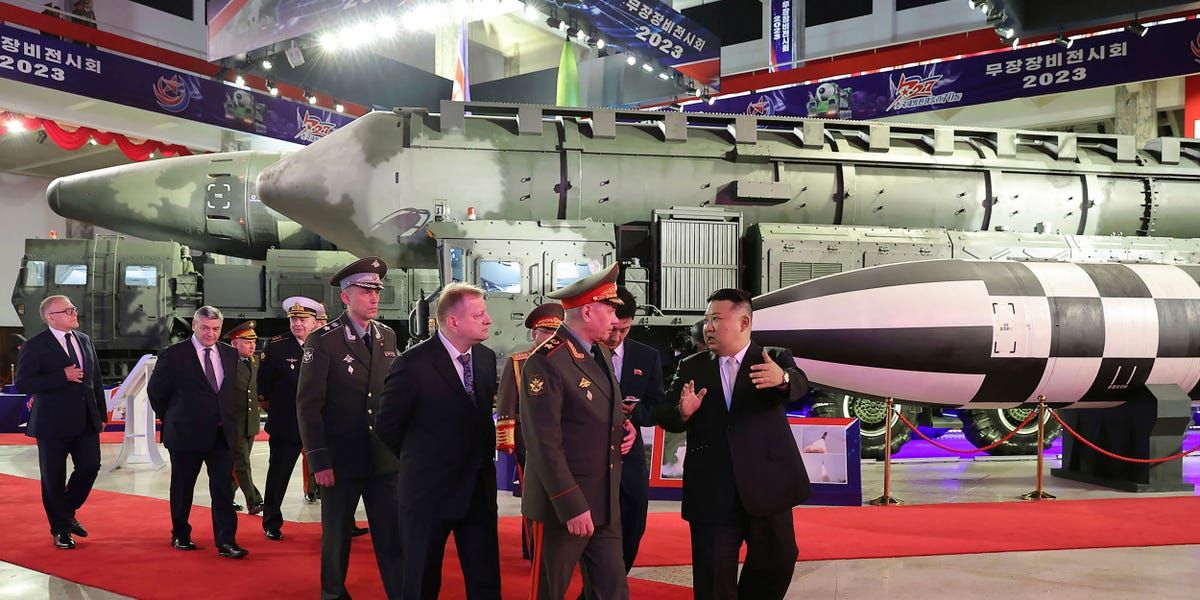North Korea Showed Russia One of Its More Troubling Nuclear Missiles
North Korea hosted Russian and Chinese officials for a state visit this week.
Kim Jong-Un showed off his arsenal, including North Korea's newest ICBM, a powerful missile that is among the most troubling.
Recent testing indicates the development of the Hwasong-18 has been a priority for Kim.
Get the inside scoop on today’s biggest stories in business, from Wall Street to Silicon Valley — delivered daily. Loading Something is loading. Thanks for signing up! Access your favorite topics in a personalized feed while you're on the go. download the app Email address By clicking ‘Sign up’, you agree to receive marketing emails from Insider as well as other partner offers and accept our Terms of Service and Privacy Policy
North Korea is hosting Russian and Chinese officials this week commemorating the 70th anniversary of the armistice that led to a cessation of Korean War hostilities. And part of the jam-packed state visit's agenda included Kim Jong Un showing off his arsenal of missiles capable of carrying nuclear warheads, including its newest ballistic missile achievement.
Some armistice anniversary, huh?
On Thursday, Kim met with Russian Minister of Defense Sergei Shoigu to discuss military and security issues, according to North Korean state media.
That meeting involved a tour of a North Korean defense exhibition featuring new weaponry, including the country's new Hwasong-18 intercontinental ballistic missile, a nuclear-capable missile North Korea developed and tested in defiance of international attempts — like those by the UN — to regulate its weapons programs and curb its nuclear ambitions.
These attempts have often been hindered by both Russia and China.
The Hwasong-18 ICBM is a technological leap forward for North Korea's weapons program and represents an upgrade from liquid-fueled systems the preceded it, such as the massive Hwasong-17 tested last year and the earlier Hwasong-14 and Hwasong-15 tested a few years earlier.
The Hwasong-18, like the Russian Topol-M ICBM, is a solid-fueled three-stage missile. It can theoretically deliver a nuclear warhead to a distant target at intercontinental range, though questions about survivability, especially during atmospheric reentry remain.
North Korea hasn't conducted a nuclear test since 2017, so it's unclear what the priorities and timeline of their program are.
A North Korean Hwasong-17 intercontinental ballistic missile on March 24, 2022. API/Gamma-Rapho via Getty Images
Whereas the Hwasong-17 was liquid-fueled — meaning it requires the fuel and oxidizer to be loaded on-site just before its launch — the Hwasong-18 is solid-fueled and can be prepared well before potential use and fired with little to no warning. From an adversary's perspective, these missiles can be seen as a more dangerous threat given the decreased time to act before it's in the air.
Not only do liquid-propellant systems require more time to fuel, leaving them exposed, they also require more supporting systems and personnel, creating a bigger radar signature.
Although solid-fueled missiles make sudden attacks easier and are more difficult to detect, they are sensitive to temperature changes, meaning they need to stored in canisters or silos for regulation. The Hwasong-18 canisters are, however, conveniently carried on road mobile transporter erector launchers.
The Chinese and Russian ICBM programs have both liquid- and solid-fueled systems.
Ian Williams, deputy director of the Missile Defense Project at the CSIS, previously told Insider that North Korea has prioritized the use of solid-fueled missiles, as indicated by some of its short-range and medium-range ballistic missile developments.
Earlier this month, North Korea conducted a test launch of the Hwasong-18 intercontinental ballistic missile. REUTERS
Kim tested the Hwasong-18 earlier this month and in April. The latest missile was launched on a lofted trajectory as opposed to a ballistic trajectory — which is done so as not to hit land or trigger any undesired responses. It flew almost 4,000 miles high, double the height of April's test, and flew for 74 minutes, the longest flight duration for North Korea's ICBMs thus far, according to North Korean state media.
On a normal ballistic trajectory, the Hwasong-18 can potentially travel to thousands of miles to deliver a nuclear strike to land-based targets. It's unclear, however, what the exact range is or whether it could hit a target in the continental US. It is a possibility though.
It's also currently unclear whether Russia and China's visit this week could potentially conclude with a demonstration of the Hwasong-18 missile or other military assets. Either way, the state visit is still monumental for other reasons.
It's only the second known time that foreign government officials have visited North Korea since the start of the COVID-19 pandemic, and the visit also comes as US-South Korean officials continue to conduct large-scale military exercises in the region.
Source: Business Insider


